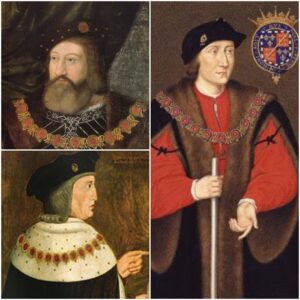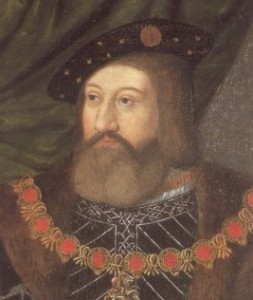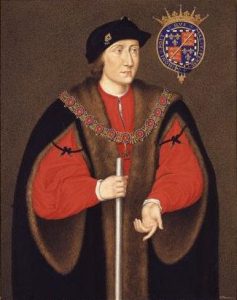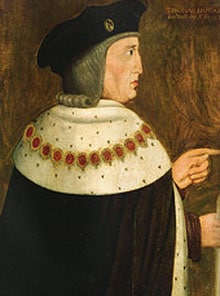 On this day in history, 1st February 1514, Candlemas Eve, King Henry VIII granted the dukedom of Suffolk to Charles Brandon, his future brother-in-law and close friend. He also granted the dukedom of Norfolk to Thomas Howard (Earl of Surrey and son of John Howard, 1st Duke of Norfolk) and Thomas’s son, who was also named Thomas, became the Earl of Surrey. Charles Somerset, Lord Herbert and the King’s Chamberlain, was made Earl of Worcester and was granted the office of chamberlain “for life, in as ample a form as he has held the office from the first day of the reign”.
On this day in history, 1st February 1514, Candlemas Eve, King Henry VIII granted the dukedom of Suffolk to Charles Brandon, his future brother-in-law and close friend. He also granted the dukedom of Norfolk to Thomas Howard (Earl of Surrey and son of John Howard, 1st Duke of Norfolk) and Thomas’s son, who was also named Thomas, became the Earl of Surrey. Charles Somerset, Lord Herbert and the King’s Chamberlain, was made Earl of Worcester and was granted the office of chamberlain “for life, in as ample a form as he has held the office from the first day of the reign”.
Here is the record of these grants:
“Thomas earl of Surrey, Treasurer of England. Creation as Duke of Norfolk, in tail male; with annuity of 40l. out of the counties of Norfolk and Suffolk, and all usual privileges also in tail male,—and grant, to him and his heirs for ever, of an addition to his coat of arms (in commemoration of his victory over James king of Scots, at Brankston), viz., on a bend on the shield of Howard a demilion gules, pierced in the mouth with an arrow, and colored according to the arms of Scotland, as borne by the said King of Scots. Also, grant in tail male of the manors of Acton Burnell, Holgote, Abbeton, Millenchop, Longdon, Chatwall, Smythcote, Wolstanton, Uppyngton, and Russhebury, Salop; of Sullihull, Warw.; of Wolverhampton, Staff.; of Birdhurst and Updon Lovell, Wilts; of Erdescote, Berks; of Honnesdon, Estwike, Barley and Hide, Herts; of Kentcote and Herdwike, Oxon; of Estwikham, Kent; of Bollesover castle, Horsley cum castro and Horston, Derby; and of Clippeston, Lymby, Mancefeld Maner, Mancefeld Wodhous, and Sutton in Asshefeld, Notts.”
“Thomas lord Howard, Admiral of England. Creation as Earl of Surrey, for life, with annuity of 20l. out of the counties of Surrey and Sussex; and grant, for life, of the castle, honor and manor of Folkyngham, the castle and manor of Cathorp, the manors of Westburght, Stupton, Dodyngton, Ryskyngton, Dygby, Hekyngton, Asselakby, Welborn, Saperton, Wynterton, Burthorp, Lynwood, Beamount, and Bayons, Linc., and the manors and tenements of Hangate and Beamount and the rents called “Beamountes rent,” in the city of Lincoln. In consideration of the timely assistance he rendered his father, Thomas, late earl of Surrey, now Duke of Norfolk, at the battle of Branxton, 9 Sept. last.
This creation is made on surrender by the said Duke (by deed dated 1 Feb. 5 Hen. VIII.) for the life of his son, of the title of Earl of Surrey, and of the annuity of 20l., granted to him in tail male, by patent 28 June 1 Ric. III.”
“Charles Somerset Lord Herbert, the King’s Chamberlain. Creation, with the assent of Parliament, as Earl of Worcester, in tail male; with annuity of 20l. out of the county of Worcester. […]
Charles Somerset Lord Herbert, the King’s Chamberlain. To be chamberlain, for life, in as ample a form as he has held the office from the first day of the reign.”
“Charles Brandon Viscount Lisle. Creation as Duke of Suffolk, in tail male, with grant, in tail male, of the manor, castle and park of Donyngton, Berks, and an annuity of 40l. out of the counties of Norfolk, Suffolk, and Cambridge.”
Who were these men?
 Charles Brandon was the son of Sir William Brandon, who is known for being Henry VII’s standard bearer at the Battle of Bosworth and for being killed by King Richard III, and his wife Elizabeth Bruyn. Charles Brandon was born in around 1484, making him seven years older than King Henry VIII.
Charles Brandon was the son of Sir William Brandon, who is known for being Henry VII’s standard bearer at the Battle of Bosworth and for being killed by King Richard III, and his wife Elizabeth Bruyn. Charles Brandon was born in around 1484, making him seven years older than King Henry VIII.
By 1503, Brandon was at court serving Henry VII at table and he had risen to become an esquire of the body by 1507. He got to know the king’s second son, the future Henry VIII, and in the early years of Henry VIII’s reign he was a member of the close-knit group surrounding the king and by 1513/14 he’d risen to be the king’s favourite and best friend. He’d go on to marry the king’s favourite sister, Mary Tudor, Queen of France in 1515, and although they married without the king’s permission, causing scandal and provoking the king’s ire, the friendship between king and courtier survived and they were close until the duke’s death in 1545.
 Charles Somerset, or Beaufort, was the illegitimate son of Henry Beaufort, 2nd Duke of Somerset, and his mistress, Joan Hill, making him related to Lady Margaret Beaufort and her son, Henry VII. He was born in around 1460 and grew up in exile in Flanders, returning to England with Henry Tudor (Henry VII) in 1485 when Henry Tudor returned to claim the crown. He was knighted when they landed at Mill Bay on 7th August 1485.
Charles Somerset, or Beaufort, was the illegitimate son of Henry Beaufort, 2nd Duke of Somerset, and his mistress, Joan Hill, making him related to Lady Margaret Beaufort and her son, Henry VII. He was born in around 1460 and grew up in exile in Flanders, returning to England with Henry Tudor (Henry VII) in 1485 when Henry Tudor returned to claim the crown. He was knighted when they landed at Mill Bay on 7th August 1485.
He served Henry VII as yeoman of the guard and royal cupbearer, was invested as a Knight of the Garter in 1496, and became vice-chamberlain of the household in 1501, a knight of the body in 1503 and a councillor in 1505. In 1504, he was made Baron Herbert. He was one of King Henry VII’s closest and most trusted advisors. Royal favour continued into Henry VIII’s reign with him receiving a number of grants after the new king’s accession and being made lord chamberlain on 30th May 1509. He was made Earl of Worcester as a reward for his role in capturing Thérouanne in the French campaign of 1513.
 Thomas Howard, Earl of Surrey, was the son of John Howard, 1st Duke of Norfolk, and his wife, Catherine Moleyns, and was born in 1443. He entered royal service in the 1460s, becoming one of King Edward IV’s henchmen. He fought for Edward at the Battle of Barnet in 1471 and was injured but he recovered and was made an esquire of the body. He was knighted in 1478.
Thomas Howard, Earl of Surrey, was the son of John Howard, 1st Duke of Norfolk, and his wife, Catherine Moleyns, and was born in 1443. He entered royal service in the 1460s, becoming one of King Edward IV’s henchmen. He fought for Edward at the Battle of Barnet in 1471 and was injured but he recovered and was made an esquire of the body. He was knighted in 1478.
In 1483, Thomas and his father John supported Richard III when he took the throne. The new king made John Duke of Norfolk and Thomas Earl of Surrey. John commanded the vanguard of Richard III’s army at the Battle of Bosworth and Thomas fought with him. John was killed in the battle and Thomas was injured. Both men were attainted by the victor, Henry VII, in his first Parliament for their support of Richard and the Norfolk title and lands were taken by the crown. Thomas was imprisoned in the Tower of London and it is thought that his refusal to escape during the Earl of Lincoln’s rebellion of 1487 convinced Henry VII of Thomas’s loyalty. He was restored to the earldom of Surrey in 1489 and served Henry VII as king’s lieutenant in the north, as a councillor, as Lord High Treasurer and as a diplomat.
He was also one of Henry VII’s executors and served as Earl Marshal at Henry VIII’s coronation in 1509. Thomas was made Duke of Norfolk in 1514 following the victory of the force he led against the Scots at the Battle of Flodden in September 1513. His son, Thomas, had fought with him and so was rewarded by being made Earl of Surrey.
Notes and Sources
- ‘Henry VIII: February 1514, 21-28’, in Letters and Papers, Foreign and Domestic, Henry VIII, Volume 1, 1509-1514, ed. J S Brewer (London, 1920), pp. 1163-1179, GRANTS IN FEBRUARY, 1514. British History Online http://www.british-history.ac.uk/.
- Gunn, S. (2004-09-23). Brandon, Charles, first duke of Suffolk (c. 1484–1545), magnate, courtier, and soldier. Oxford Dictionary of National Biography. http://www.oxforddnb.com.
- Crawford, A. (2004-09-23). Howard, John, first duke of Norfolk (d. 1485), soldier and member of parliament. Oxford Dictionary of National Biography. http://www.oxforddnb.com.
- Head, D. (2004-09-23). Howard, Thomas, second duke of Norfolk (1443–1524), magnate and soldier. Oxford Dictionary of National Biography. http://www.oxforddnb.com.
- Hughes, J. (2004-09-23). Somerset [formerly Beaufort], Charles, first earl of Worcester (c. 1460–1526), courtier and magnate. Oxford Dictionary of National Biography. http://www.oxforddnb.com.